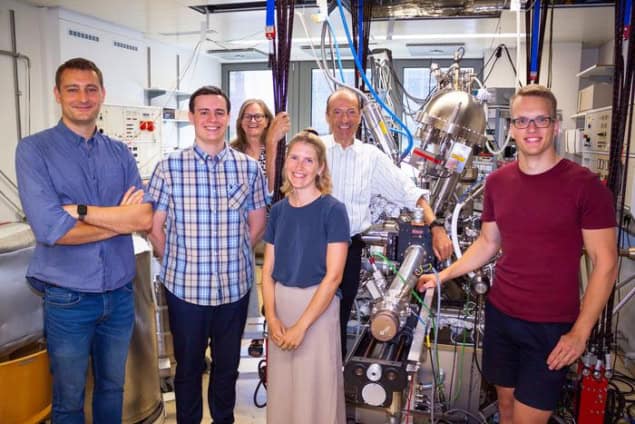
Determining the surface structure of an insulating material is a difficult task, but it is important for understanding its chemical and physical properties. A team of researchers in Austria has now succeeded in doing just this for the technologically important insulator aluminium oxide (Al2O3). The team’s new images – obtained using non-contact atomic force microscopy (AFM) – not only reveal the material’s surface structure but also explain why a simple cut through a crystal is not energetically favourable for the material and leads to a complex rearrangement of the surface.
Al2O3 is an excellent insulator and is routinely employed in many applications, for example as a support material for catalysts, as a chemically resistant ceramic and in electronic components. Characterizing how the surface atoms arrange themselves in this material is important for understanding, among other things, how chemical reactions occur on it.
A technique that works for all materials
Atoms in the bulk of a material arrange themselves in an ordered crystal lattice, but the situation is very different on the surface. The more insulating a material is, the more difficult it is to analyse its surface structure using conventional experimental techniques, which typically require conductivity.
Researchers led by Jan Balajka and Johanna Hütner at TU Wien have now used non-contact AFM to study the basal (0001) plane of Al2O3. This technique works – even for completely insulating materials – by scanning a sharp tip mounted on a quartz tuning fork at a distance of just 0.1 nm above a sample’s surface. The frequency of the fork varies as the tip interacts with the surface atoms and by measuring these changes, an image of the surface structure can be generated.
The problem is that while non-contact AFM can identify where the atoms are located, it cannot distinguish between the different elements making up a compound. Balajka, Hütner and colleagues overcame this problem by modifying the tip and attaching a single oxygen atom to it. The oxygen atoms on the surface of the sample being studied repel this oxygen atom, while its aluminium atoms attract it.
“Mapping the local repulsion or attraction enabled us to visualize the chemical identity of each surface atom directly,” explains Hütner. “The complex three-dimensional structure of the subsurface layers was then determined computationally with novel machine learning algorithms using the experimental images as input,” adds Balajka.
Surface restructuring
According to their analyses, which are detailed in Science, when a cut is made on the Al2O3 surface, it restructures so that the aluminium in the topmost layer is able to penetrate deeper into the material and chemically bond with the oxygen atoms therein. This reconstruction energetically stabilizes the structure, but it remains stoichiometrically the same.
“The atomic structure is a foundational attribute of any material and is reflected in its macroscopic properties,” says Balajka. “The surface structure governs any surface chemistry, such as chemical reactions in catalytic processes.”
Balajka says that the challenges the team had to overcome in this work were threefold: “The first was the strongly insulating character of the material; the second, the lack of chemical sensitivity in (conventional) scanning probe microscopy; and the third, the structural complexity of the alumina surface, which leads to a large configuration of possible structures.”

Alumina glass bends rather than breaking
As an enigmatic insulator, alumina has posed significant challenges for experimental studies and its surface structure has evaded precise determination since 1960s, Balajka tells Physics World. Indeed, it was listed as one of the “three mysteries in surface science” in the late 1990s.
The new findings provide a fundamental piece of knowledge: the detailed surface structure of an important material, and pave the way for advancement in catalysis, materials science and many other fields, he adds. “The experimental and computational approaches we employed in this study can be applied to study other materials that have been too complex or inaccessible to conventional techniques.”



